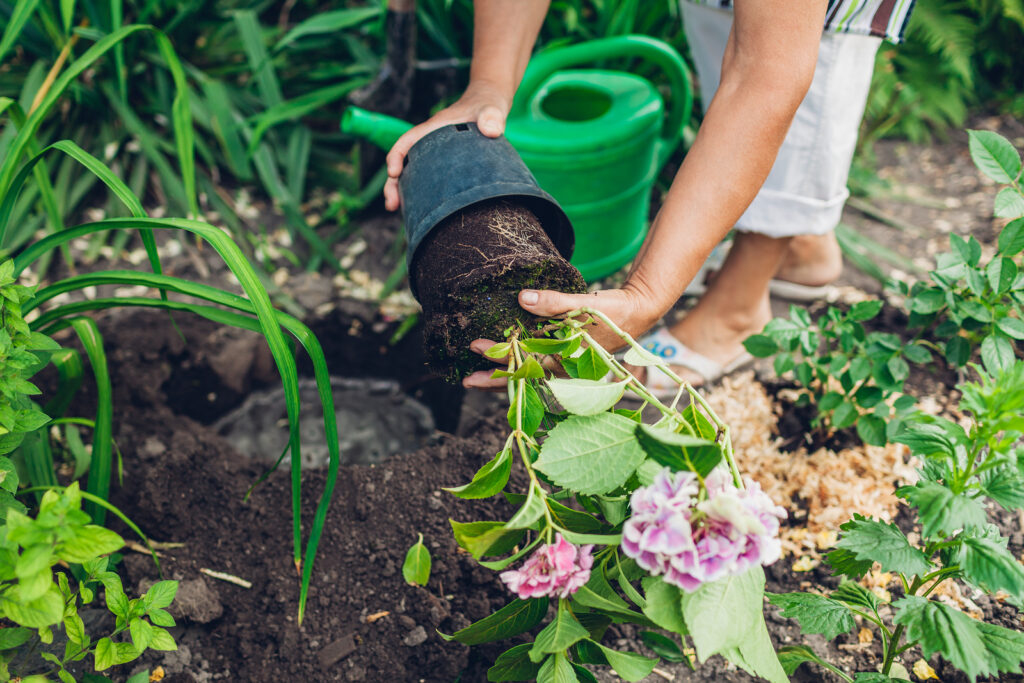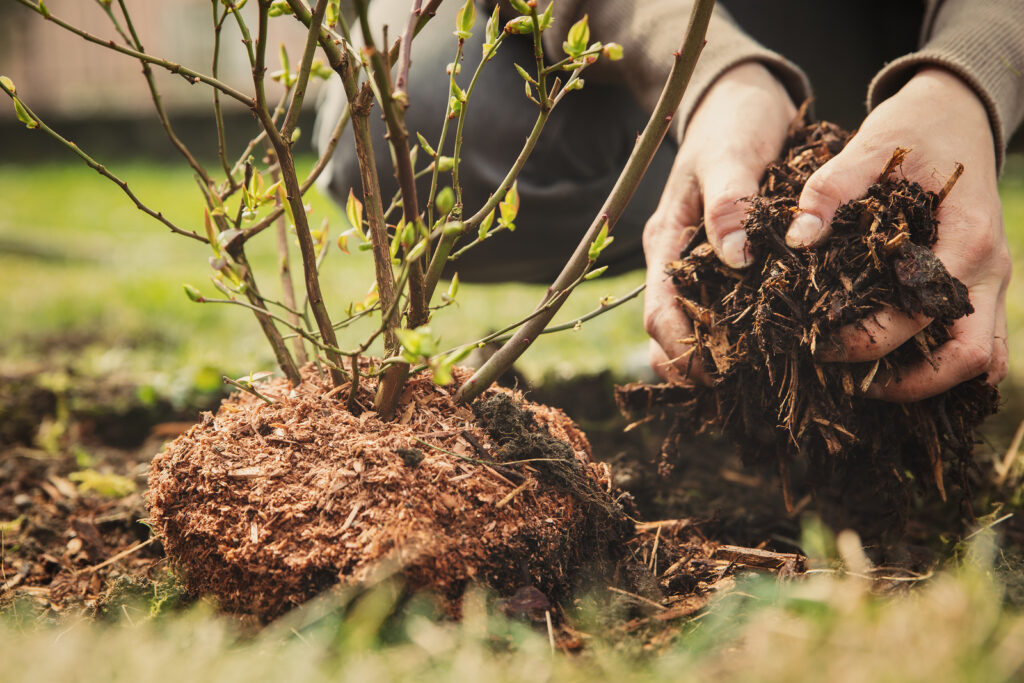Shrubs add shape and structure to a garden. Most are also decorative—colorful or evergreen foliage, colorful and often fragrant flowers, fruits, and shapely stems.
Shrubs stay a long time in the garden so it’s important to choose shrubs that have the form and size needed when mature. Know the eventual height and spread of a shrub before you add it to the garden.
Some shrubs are fast-growing and some may take years to mature. Know what pruning or care it will need as it grows. Consider how the shrub will fit in and add to the garden design.

How to select shrubs
Shrubs should be healthy, undamaged, and free of pests and diseases. Select a shrub with evenly distributed branches close to ground level. Here are a few things to keep in mind when you go to buy a shrub:
- Shrubs can be purchased container-grown, bare-root, or balled-and-burlapped. Deciduous shrubs, not evergreens, are sold bare-root; often they are younger container-grown trees. Container-grown and ball-and-bulapped will be older—and more expensive.
- Shrubs can be purchased in a variety of sizes and stages of maturity. Young shrubs are often quicker to establish themselves, to root. Older shrubs are larger and can make an immediate impact.
- If you want to purchase a container-grown shrub, you may want to remove it from the container so you can check the roots. The shrub should be well-rooted but not pot-bound with roots circling in the container. Healthy roots will have white tips. The soil in the container should cling to the roots not fall away when the roots when taken from the pot. Container grown shrubs can be planted at any time, but spring and fall are optimal. Don’t plant shrubs during a heatwave.
- If you want to purchase a balled-and-burlapped shrub (that means the roots will be wrapped in burlap and netting), make sure the shrub that the burlap is intact—this means the roots have not been exposed wind. The root ball should be firm. Balled-and-burlapped shrubs are usually deciduous and sold in early spring before they leaf out. The best time to plant a balled-and-burlapped shrub is in spring; the second-best time is fall.
- If you want to purchase a bare-root shrub, make sure the shrub has well-developed roots that spread evenly in each direction. Make sure the roots are plump and moist, not withered or dry. Bare-root shrubs such as roses are usually sold in spring. Spring is the best time to plant bare-root trees.
When to plant shrubs
Here’s a simple guide to know the best times to plant shrubs:
- The best time to plant shrubs is from fall to spring. Planting in fall allows roots to become established while the soil is still warm; that will allow the plant to resume growth in spring and gain strength before the summer heat.
- In warm and mild winter regions where the ground does not freeze, shrubs can be planted in winter.
Site preparation ahead of planting shrubs
Prepare the planting site in advance of planting. Here’s how:
- Choose a well-drained site. Soil that drains poorly may be difficult to fix; start by amending the soil with aged compost or commercial organic planting mix. A hole filled with water that does not naturally drain in 8 hours may be a poor site for planting.
- Remove sod and weeds from the planting area; this eliminates competition for nutrients and soil moisture. It is important to remove all perennial weeds which can be deep-rooted.
- For shrubs being planted in borders or flower beds, turn the soil deeply—twice as deep and wide as the root ball of the shrub to be planted–and add aged compost or commercial organic planting mix and work it into the soil thoroughly.
- Prepare a hole two to four times as wide and half again as deep as the tree’s root ball, even larger is better. Use a garden fork to score the sides of the hole; this will allow roots to spread more easily into the native soil.
- Sprinkle an all-purpose shrub fertilizer into the bottom of the hole and then lightly cover the fertilizer with soil. This will give roots a boost when they grow down to the fertilizer.

Planting a container-grown shrub
- Moisten the soil in the container; stand the container in water for half an hour or until the soil is moist.
- Remove the container being careful not to damage the shrub or its roots; you can slide the shrub from the container or you may need to cut the container away.
- Tease the roots away from the root ball; use your fingers or a hand fork. Do not plant a root-bound shrub. Do the same for a balled-and-burlapped shrub; score the soil around the root ball.
- To plant bare-root shrubs, remove the shrub from its package, create a cone of soil at the bottom of the planting hole; spread the roots out in fan-fashion running down the cone.
- Trim away any broken or damaged roots.
- Check the planting depth of the hole; place the shrub in the hole and check the soil mark—a dark mark near the base of the stem; this indicates the level the tree was growing in the container or nursery. Place a stake across the hole alongside the stem; add soil beneath the root ball so that the soil mark is level with the stake.
- Backfill the hole around and over the roots firming in the soil as you go; firming the soil will remove air pockets around the roots.
- Water well and apply thick mulch around the shrub to conserve soil moisture.
Planting a bare-root shrub
- Prepare the site as you would for container-grown shrub; the hole should be wide enough for the shrub’s roots to be spread fully.
- Create a cone of soil at the bottom of the hole; set the shrub on top of the cone and spread the roots down the cone in all directions. Adjust the planting depth as needed.
- Partially backfill the hole; be sure the soil is filling in around the roots.
- Continue to backfill and firm the soil in place until the hole is filled.
- Water the shrub well and mulch around the plant to stem soil moisture evaporation.

Planting balled-and-burlapped shrub
- Prepare the planting site.
- Prepare the planting hole; the hole should be twice the width of the ball, or in clay soils, three times the width.
- Place the shrub in the hole to the correct depth then loosen the burlap or netting around the root ball.
- Score the edges of the soil around the roots then backfill the hole. This will help the roots grow into the surrounding soil.
- Water thoroughly and mulch.
Shrub care after planting
- Keep newly planted shrubs well-watered for a year or two after planting especially during hot weather and drought.
- Keep the surrounding area free of grass and weeds which can compete for soil moisture and nutrients.
- Mulch around shrubs to keep weeds down and conserve soil moisture.
- Protect shrubs from drying winds and very cold temperatures. Erect a burlap screen upwind from shrubs.
- Protect shrubs in winter from freezing temperatures with row covers or plant blankets. Mulch around the base of shrubs with straw or chopped leaves to protect roots from freezing temperatures.
Planting shrubs in containers
Plant shrubs in containers in late summer or fall.
- Select a container that is at least 2 inches (5cm) wider and deeper than the root ball of the shrub, or 2 inches wider and deeper than the previous container.
- Heavy containers should be positioned before planting. Place the container in a saucer or on pot feet or blocks to ensure drainage.
- Place screening over the drain hole to keep soil from falling through.
- Use a soil-based potting mix rich in nutrients. Avoid peat-based potting mixes which dry out rapidly in hot weather.
- Place soil in the bottom of the container then set the shrub in place; backfill potting mix around the roots being sure to eliminate air pockets.
- Make sure that the soil mark on the shrub stem is level with the surfaces of the soil mix.















